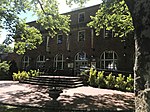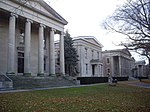St. Peter's Boys High School
1917 establishments in New York CityAC with 0 elementsAll pages needing cleanupBoys' schools in New York CityEducational institutions established in 1917 ... and 5 more
Lasallian schools in the United StatesRoman Catholic high schools in Staten IslandUse American English from November 2022Use mdy dates from November 2022West New Brighton, Staten Island
St. Peter's Boys High School is an American Catholic all-boys' high school, located in the West New Brighton area of the Staten Island borough of New York City, New York. The school is affiliated with the Christian Brothers of St. John Baptist de la Salle, and is a member of the Catholic High School Athletic Association. The school is located at 200 Clinton Avenue and is part of St. Peter's parish on Staten Island, which also ran a grammar school and all-girls' high school.
Excerpt from the Wikipedia article St. Peter's Boys High School (License: CC BY-SA 3.0, Authors).St. Peter's Boys High School
Clinton Avenue, New York Staten Island
Geographical coordinates (GPS) Address External links Nearby Places Show on map
Geographical coordinates (GPS)
| Latitude | Longitude |
|---|---|
| N 40.639166666667 ° | E -74.099166666667 ° |
Address
St. Peter's Boys High School (Saint Peter's High School for Boys)
Clinton Avenue
10301 New York, Staten Island
New York, United States
Open on Google Maps









